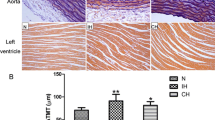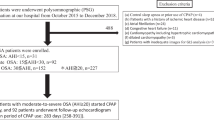Abstract
Purpose
We aimed to investigate the effect of obstructive sleep apnea (OSA) and apnea–hypopnea duration on endothelial, ventricular function, blood pressure, and inflammation in a rat model.
Methods
We established a novel rat model of OSA. Wistar rats were randomized to six groups according to 4-week different treatments: (1) OSA (apnea for 60 s in a 90-s window of breathing [60 s/90 s] with anesthesia), (2) OSA 30 s/90 s with anesthesia, (3) partial recovery (60 s/90 s for 2 weeks, followed by 15 s/90 s for 2 weeks with anesthesia), (4) complete recovery (60 s/90 s for 2 weeks with anesthesia, and then normal breathing for 2 weeks), (5) sham (normal breathing in the device with anesthesia), and (6) control group (normal breathing, normal cage, no anesthesia). We recorded blood pressure, endothelial function, left ventricular function, and inflammation at different time points.
Results
Vascular inflammation and endothelial dysfunction occurred in OSA models. More systemic inflammatory and endothelial dysfunction were observed in longer apnea–hypopnea duration group and they were reversed in both partial and complete recovery groups. Left ventricular weight/body weight ratio was significantly higher in the OSA (60s/90s) group than complete recovery, sham, and control groups, which remained unchanged in partial recovery group (p < 0.05).
Conclusions
Longer apnea–hypopnea duration is related to more systemic inflammatory and endothelial dysfunction, and hypertension and cardiac remodeling. These can be reversed after a period of recovery, which indicates that time parameters for assessing OSA, such as apnea–hypopnea duration, should be considered instead of apnea–hypopnea index only.






Similar content being viewed by others
References
Heinzer R, Vat S, Marques-Vidal P, Marti-Soler H, Andries D, Tobback N, Mooser V, Preisig M, Malhotra A, Waeber G, Vollenweider P, Tafti M, Haba-Rubio J (2015) Prevalence of sleep-disordered breathing in the general population: the HypnoLaus study. Lancet Respir Med 3:310–318
Javaheri S, Barbe F, Campos-Rodriguez F, Dempsey JA, Khayat R, Javaheri S, Malhotra A, Martinez-Garcia MA, Mehra R, Pack AI, Polotsky VY, Redline S, Somers VK (2017) Sleep apnea: types, mechanisms, and clinical cardiovascular consequences. J Am Coll Cardiol 69:841–858
Anu MM, Antti K, Mikko H, Salla K, Taina H, Pekka T et al (2013) The severity of individual obstruction events is related to increased mortality rate in severe obstructive sleep apnea. J Sleep Res 22:663–669
Kulkas A, Tiihonen P, Julkunen P, Mervaala E, Töyräs J (2013) Novel parameters indicate significant differences in severity of obstructive sleep apnea with patients having similar apnea–hypopnea index. Med Biol Eng Comput 51:697–708
Seif F, Patel SR, Walia H, Rueschman M, Bhatt DL, Gottlieb DJ, Lewis EF, Patil SP, Punjabi NM, Babineau DC, Redline S, Mehra R (2013) Association between obstructive sleep apnea severity and endothelial dysfunction in an increased background of cardiovascular burden. J Sleep Res 22:443–451
Alex R, Manchikatla S, Machiraju K, Altuwaijri E, Watenpaugh DE, Zhang R et al (2014) Effect of apnea duration on apnea induced variations in cerebral blood flow velocity and arterial blood pressure. Eng Med Biol Soc 270–3
Li HY, Wang PC, Chen YP, Lee LA, Fang TJ, Lin HC (2011) Critical appraisal and meta-analysis of nasal surgery for obstructive sleep apnea. Am J Rhinol Allergy 25:45–49
Ishii L, Roxbury C, Godoy A, Ishman S, Ishii M (2015) Does nasal surgery improve OSA in patients with nasal obstruction and OSA? A meta-analysis. Otolaryngology--head and neck surgery: official journal of American Academy of Otolaryngology-Head and Neck. Surgery 153:326–333
Sufioğlu M, Ozmen OA, Kasapoglu F, Demir UL, Ursavas A, Erişen L, Onart S (2012) The efficacy of nasal surgery in obstructive sleep apnea syndrome: a prospective clinical study. Eur Arch Oto-Rhino-L 269:487–494
Bostanci A, Bozkurt S, Turhan M (2015) The relationship between the duration of obstructive respiratory events and outcomes of multilevel upper airway surgery in patients with obstructive sleep apnea. European archives of oto-rhino-laryngology: official journal of the European Federation of Oto-Rhino-Laryngological Societies (EUFOS) : affiliated with the German Society for Oto-Rhino-Laryngology - Head and Neck. Surgery 273:1–7
Asha’Ari ZA, Rahman JA, Mohamed AH, Abdullah K, Leman WI (2017) Association between severity of obstructive sleep apnea and number and sites of upper airway operations with surgery complications. JAMA Otolaryngol Head Neck Surg 143:239–246
Pang KP, Pang EB, Pang KA, Vicini C, Chan YH Rotenberg BW (2017) Upper airway surgery for obstructive sleep apnea reduces blood pressure. Laryngoscope 128(9464)
Wu H, Zhan X, Zhao M, Wei Y (2016) Mean apnea-hypopnea duration (but not apnea-hypopnea index) is associated with worse hypertension in patients with obstructive sleep apnea. Medicine (Baltimore) 95:e5493
Lee KZ, Hsu SH (2017) Compensatory function of the diaphragm following high cervical hemisection in the rat. J Neurotraum 34:2634–2644
Zhang H, Liu J, Qu D, Wang L, Luo JY, Lau CW, Liu P, Gao Z, Tipoe GL, Lee HK, Ng CF, Ma RCW, Yao X, Huang Y (2016) Inhibition of miR-200c restores endothelial function in diabetic mice through suppression of COX-2. Diabetes 65:1196–1207
Cunningham JT, Knight WD, Mifflin SW, Nestler EJ (2012) An essential role for DeltaFosB in the median preoptic nucleus in the sustained hypertensive effects of chronic intermittent hypoxia. Hypertension 60:179–187
Tagaito Y, Polotsky VY, Campen MJ, Wilson JA, Balbir A, Smith PL, Schwartz AR, O’Donnell CP (2001) A model of sleep-disordered breathing in the C57BL/6J mouse. J Appl Physiol 91:2758–2766
Iwasaki YK, Kato T, Xiong F, Shi YF, Naud P, Maguy A, Mizuno K, Tardif JC, Comtois P, Nattel S (2014) Atrial fibrillation promotion with long-term repetitive obstructive sleep apnea in a rat model. J Am Coll Cardiol 64:2013–2023
Almendros I, Farré R, Planas AM, Torres M, Bonsignore MR, Navajas D, Montserrat JM (2011) Tissue oxygenation in brain, muscle, and fat in a rat model of sleep apnea: differential effect of obstructive apneas and intermittent hypoxia. Sleep 34:1127–1133
Nadeem R, Molnar J, Madbouly EM, Nida M, Aggarwal S, Sajid H et al (2013) Serum inflammatory markers in obstructive sleep apnea: a meta-analysis. J Clin Sleep Med 9:1003
Vitulano N, Di MBA, Re A, Riccioni G, Perna F, Mormile F et al (2013) Obstructive sleep apnea and heart disease: the biomarkers point of view. Front Biosci S5:588–599
Endemann DH, Schiffrin EL (2004) Endothelial dysfunction. J Am Soc Nephrol 15:1983–1992
Lindsay MM, Maxwell PDunn FG (2002) TIMP-1: a marker of left ventricular diastolic dysfunction and fibrosis in hypertension. Hypertension 40:136–141
Parati G, Ochoa JE, Bilo G, Mattaliano P, Salvi P, Kario K et al (2014) Obstructive sleep apnea syndrome as a cause of resistant hypertension. Hypertens Res 37:601–613
Takawale A, Zhang P, Patel VB, Wang X, Oudit G, Kassiri Z (2017) Tissue inhibitor of matrix metalloproteinase-1 promotes myocardial fibrosis by mediating CD63-integrin β1 interaction. Hypertension
Marchesi C, Dentali F, Nicolini E, Maresca AM, Tayebjee MH, Franz M, Guasti L, Venco A, Schiffrin EL, Lip GYH, Grandi AM (2012) Plasma levels of matrix metalloproteinases and their inhibitors in hypertension: a systematic review and meta-analysis. J Hypertens 30:3–16
Dhingra R, Pencina MJ, Schrader P, Wang TJ, Levy D, Pencina K, Siwik DA, Colucci WS, Benjamin EJ, Vasan RS (2009) Relations of matrix remodeling biomarkers to blood pressure progression and incidence of hypertension in the community. Circulation 119:1101–1107
Ferretti G, Bacchetti T, Banach M, Simentalmendía LE, Sahebkar A (2016) Impact of statin therapy on plasma MMP-3, MMP-9, and TIMP-1 concentrations. Angiology 2016293031507
Lambert E, Dassé E, Haye B, Petitfrère E (2004) TIMPs as multifacial proteins. Crit Rev Oncol Hematol 49:187–198
Acknowledgements
We thank Dr. Y.Y. Yang and L.Y. Li for technical assistance. Jayant M. Pinto, M.D., from the Section of Otolaryngology-Head and Neck Surgery, in the Department of Surgery, at The University of Chicago, provided useful comments. We thank John E. Sanderson, PhD, from Beijing Institute of Heart, Lung and Blood Vessel Diseases, Beijing An Zhen Hospital, Capital Medical University, and Ellen Knapp, PhD, from Liwen Bianji, Edanz Group China, for editing the English text of a draft of this manuscript.
Funding
This study was supported by NSFC (Project 81870335), Beijing Medical Project 2016-4, Beijing Key Laboratory of Upper Airway Dysfunction and Related Cardiovascular Diseases (NO: BZ0377), Beijing Municipal Administration of Hospitals Clinical Medicine Development of Special Funding Support (ZYLX201605) and Beijing Municipal Science & Technology Commission (No. Z141100006014057).
Author information
Authors and Affiliations
Contributions
WH and WY performed the study design and experiment operation and were major contributors in writing the manuscript. LQ and SH performed the sample preparation and measurement of inflammatory cytokines. ZH performed the isolation of rat thoracic aortas. QY performed the study design and data collection. FF analyzed and interpreted the data. All authors read and approved the final manuscript.
Corresponding author
Ethics declarations
Conflict of interest
The authors declare that they have no conflict of interest.
Ethics approval and consent to participate
All procedures were approved by the Animal Care and Use Committee of Capital Medical University (AEEI-2015-107). The investigation conformed to the Guide for the Care and Use of Laboratory Animals published by the U.S. National Institutes of Health (NIH Publication No.85-23, revised 1996).
Availability of data and material
The datasets used and/or analyzed during the current study are available from the corresponding author on reasonable request.
Additional information
Publisher’s note
Springer Nature remains neutral with regard to jurisdictional claims in published maps and institutional affiliations.
Rights and permissions
About this article
Cite this article
Wu, H., Lv, Q., Zhang, H. et al. The reduction of apnea–hypopnea duration ameliorates endothelial dysfunction, vascular inflammation, and systemic hypertension in a rat model of obstructive sleep apnea. Sleep Breath 23, 1187–1196 (2019). https://doi.org/10.1007/s11325-019-01798-3
Received:
Revised:
Accepted:
Published:
Issue Date:
DOI: https://doi.org/10.1007/s11325-019-01798-3




